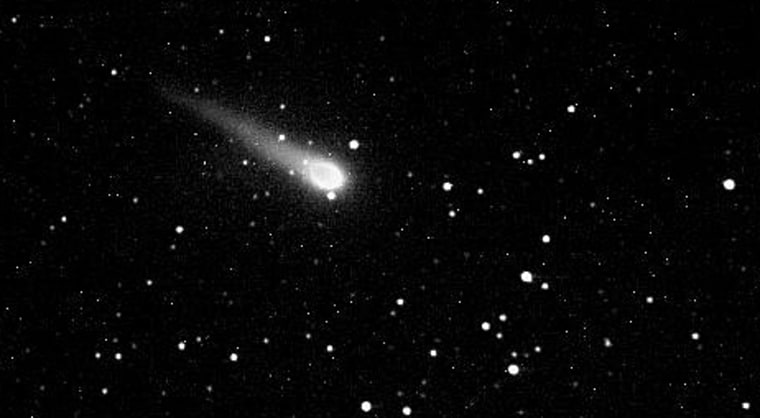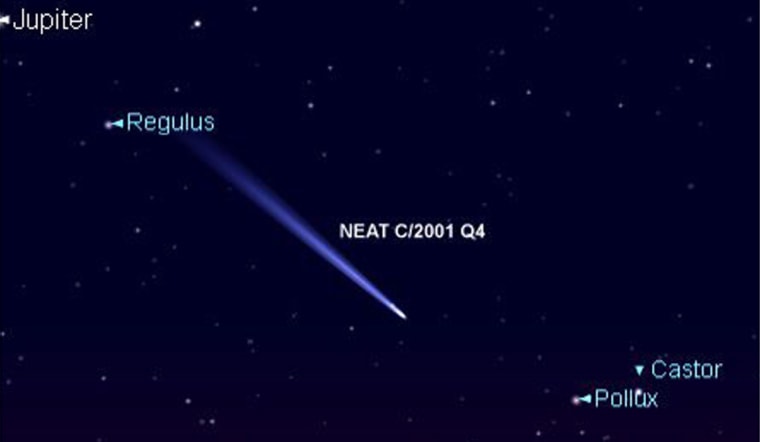During the next couple of months, interest will run high with the prospects of viewing not just one, but two potentially bright, naked-eye comets.
Both are by-products of systematic searches for asteroids that might closely approach Earth. One was discovered on Oct. 14, 2002, by the Lincoln Laboratory Near-Earth Asteroid Research survey, and was hence christened with the acronym "LINEAR." The other was found on Aug. 24, 2001, by the Near-Earth Asteroid Tracking program and goes by the acronym "NEAT."
Today we know comets to be composed primarily of frozen gases that are heated as they approach the sun and are made to glow by the sun’s light. As the gases warm and expand, the solar winds blow the expanding material out into the comet’s beautiful tail.
To observers of antiquity, the tail suggested a trail of long hair, so they called comets "hairy stars."
Rare sight for the naked eye
Professional astronomers can observe anywhere from half a dozen to a dozen comets on any given night. But comets bright enough to excite those of us without big telescopes are relatively rare, perhaps appearing on an average of one or two every 10 to 15 years.
The last time we saw a truly bright and spectacular naked-eye comet was seven years ago, during the early spring of 1997: Comet Hale-Bopp.
Just how well you might see Comets LINEAR and NEAT depends strongly on where you live. Interestingly, Southern Hemisphere observers will have a decided advantage over their northern counterparts, being blessed with two unusual opportunities to see both comets in the sky at the same time! Through most of April, they will be in the morning sky, and then from late May into early June, they’ll again be visible simultaneously in the evening sky, possibly even for a brief time to northerners as well.
Below are capsule summaries of what you should expect to see. Note that astronomers measure brightness of objects on an inverted scale. The dimmest objects visible in the night sky, under perfect conditions away from city lights, are around magnitude 6.5. The brightest stars are around magnitude 1 or 2. Negative magnitudes are reserved for the very brightest objects.
Comet LINEAR
Presently this comet (cataloged C/2002 T7) is a fifth-magnitude object in the constellation of Pisces the Fishes, but it’s much too close to the sun to be visible. That will pretty much be the story through the first week of April.
Thereafter, Comet LINEAR will begin to slowly emerge from the bright solar glare and into the morning sky. The comet should slowly brighten as it approaches both the sun and the earth. It will arrive at perihelion — its closest point to the sun — on April 23, at a distance of 57 million miles (92 million kilometers). After it moves around the sun, it should continue to noticeably brighten as it approaches Earth.
Unfortunately, for those in the Northern Hemisphere, Comet LINEAR will be quite difficult to see, since it will hover very low near the eastern horizon about an hour before sunrise, right on through the balance of April and on into the beginning of May.

Northern observers might catch only a fleeting glimpse of LINEAR, possibly as bright as second or even first magnitude, in the brightening dawn twilight at the end of April or very beginning of May. Objects this bright can be visible almost until the sun actually rises. Thereafter, the comet will no longer be able to be seen, moving too far to the south to be visible from northern latitudes.
The situation for Southern Hemisphere viewers, in contrast, will be far better. While Comet LINEAR will probably not become readily visible to most until mid-April, thereafter it will appear to climb progressively higher each morning in the east-northeast sky. During the first 10 days of May, the comet should be an easy target for observers south of the equator, rising about two to three hours before sunrise.
But then, because the comet will be rapidly approaching its closest point to Earth, its viewing aspect will also change rapidly.
During the middle part of May, the comet will make the transition from a morning to an evening object. On May 19, it will be closest to Earth, just under 25 million miles (40 million kilometers) away.
Located in the winding constellation of Eridanus the River, Comet LINEAR will be well-placed in the southwest sky right after sunset, perhaps appearing as bright as zero magnitude.
In the following days as the comet recedes from the Earth, it should fade quickly, dropping to third magnitude by the end of May and fifth magnitude by mid-June.
In the final days of May and at the very beginning of June, there is a possibility that observers in the Northern Hemisphere will again have a chance to sight Comet LINEAR, very low near the southwest horizon as darkness falls. But unless the comet ends up brighter than is expected now, it won’t be as easy task.
Comet NEAT
Also known as C/2001 Q4, Comet NEAT has been a solely a Southern Hemisphere object since its discovery in August 2001.
Currently it resides in the far-southern constellation of Tucana the Toucan, and shines at sixth magnitude. For those at far-southerly latitudes, this comet will be available as both a morning and evening object through late April, appearing in the south-southwest sky for a few hours after sundown, then reappearing above the southeast horizon a few hours before sunrise.
As it approaches both the sun and Earth, the comet should brighten accordingly, perhaps reaching third magnitude by mid-April. But its availability to early-morning viewers will also be diminishing rapidly as it gets progressively lower in the south-southeast sky and rises closer to sunrise.

Conversely, at the same time, Comet NEAT will be getting noticeably higher and more favorably placed for evening visibility. As the comet starts moving swiftly northward, two things will happen by the end of April: It will finally relinquish its morning visibility, and it will begin to become accessible as an evening object for those in the Northern Hemisphere.
During the first week of May, most northern observers will anxiously be awaiting darkness to fall, straining for clear, unobstructed views toward the southwest horizon for their first sighting of Comet NEAT. Probably the first good opportunity for most will come on the evening of May 5, approximately an hour after sunset. Look low in the southwest for blue-white Sirius the Dog Star, the brightest star in the night sky. Comet NEAT should be hovering about 10 degrees to the left of Sirius (your clinched fist, held at arm’s length, is roughly equal to 10 degrees).
The comet will be passing closest to Earth on the following evening, just under 30 million miles (48 million kilometers) away. In the nights that follow, Comet NEAT — perhaps as bright as first or second magnitude — will be getting progressively higher up in the southwest sky and correspondingly easier to see.
On May 13, a line drawn from Castor to Pollux (in Gemini) and extended out three times the distance between these two stars will bring you to Comet NEAT.
On May 15, the comet will reach its closest point to the sun, just over 89 million miles (142 million kilometers) away. It should then fade rapidly from view as it moves away from both sun and Earth, moving into Ursa Major by month’s end.
A final note of caution
Both of these comets appear capable of reaching first magnitude. That’s the good news. The bad news is that both are apparently making their very first approach to the vicinity of the sun, and history has shown that most "first-timers" usually fall far short of brightness expectations and instead end up appearing faint and unimpressive.
Since all new comets are notoriously unpredictable, we can only guess just how bright LINEAR and NEAT will get, and how long their respective tails will be. We’re just going to have to wait and see. Night Sky Friday will keep you posted on their development in the coming weeks. Stay tuned!